#Chopta auli
Explore tagged Tumblr posts
Text
Are you ready for an unforgettable adventure in the heart of the Himalayas? Join us on a captivating journey to Chopta, often dubbed the "Mini Switzerland of India." With its breathtaking landscapes, lush meadows, and stunning views of snow-capped peaks, Chopta promises a perfect escape for nature lovers and adventure seekers alike. Book Chopta tour package with TourMyHoliday!
#Chopta tungnath trek#Chopta auli#Chopta itinerary#Chopta tour package from delhi#Chopta tour package from Haridwar#Chopta complete tour package#Chopta best hotels#Delhi to chopta tour at best price#Delhi#chopta#auli complete tour package#Cheapest tour tour package of chopta#Chopta chanadrashila trek#Chopta cheapest#Chopta tour itinerary#Best resort in chopta#ChoptaTourPackage#TungnathTrek#ChoptaTripPackage#TourMyHoliday#HimalayanAdventures#ChoptaTravel#TourPackages#IncredibleIndia
3 notes
·
View notes
Text

Discover the Beauty of Chopta: Your Cheapest Chopta Tour Package by TourMyHoliday!
Discover the breathtaking beauty of Chopta with TourMyHoliday’s unbeatable 2-night, 3-day package—the Cheapest Chopta tour package available! Priced affordably, this tour offers you a perfect escape into nature, where you can explore lush meadows, stunning mountain views, and serene landscapes. Experience guided treks, cozy accommodations, and delightful meals that showcase the best of local cuisine. Whether you’re looking for adventure or relaxation, this package is designed for every traveler. Don’t miss this opportunity to immerse yourself in the enchanting beauty of Chopta without breaking the bank. Book your Cheapest Chopta tour package today and make unforgettable memories!
#ChoptaTourPackage#TungnathTrek#ChoptaTripPackage#TourMyHoliday#HimalayanAdventures#ChoptaTravel#TourPackages#IncredibleIndia#Chopta tungnath trek#Chopta auli#Chopta itinerary#Chopta tour package from delhi#Chopta tour package from Haridwar#Chopta complete tour package#Chopta best hotels#Delhi to chopta tour at best price#Delhi#chopta#auli complete tour package#Cheapest tour tour package of chopta#Chopta chandrashila trek#Chopta cheapest#Chopta tour itinerary#Best resort in chopta
0 notes
Text

Discover the Wonders of Tungnath, Chandrashila, and Deoria Tal
Nestled in the stunning Chopta Valley, Chopta is a gateway to some of the most breathtaking sights in the Indian Himalayas. Among its most popular attractions are Tungnath, Chandrashila, and Deoria Tal, each offering unique experiences for travelers seeking adventure and tranquility.
Choose TourMyHoliday for Your Chopta Tour Package
When it comes to exploring the mesmerizing landscapes of Chopta, choosing the right travel company can make all the difference. Here’s why TourMyHoliday stands out as the best Chopta tour company for your adventure. Book Chopta Tour Package!
#Chopta tungnath trek#Chopta auli#Chopta itinerary#Chopta tour package from delhi#Chopta tour package from Haridwar#Chopta complete tour package#Chopta best hotels#Delhi to chopta tour at best price#Delhi#chopta#auli complete tour package#Cheapest tour tour package of chopta#Chopta chanadrashila trek#Chopta cheapest#Chopta tour itinerary#Best resort in chopta#ChoptaTourPackage#TungnathTrek#ChoptaTripPackage#TourMyHoliday#HimalayanAdventures#ChoptaTravel#TourPackages#IncredibleIndia
0 notes
Text
#auli tour package#auli tour package ex delhi#auli tourism#activity in auli#chopta tour package#auli chopta tour#Discover-uttarkahand#holidays#uttarakhand travel
2 notes
·
View notes
Text
Luxury Chardham Yatra Package
Embark on a spiritual journey with Travel Shrine’s luxury Chardham Yatra package. Experience comfort and convenience with premium accommodations, guided tours, and personalized services. Visit the sacred temples of Yamunotri, Gangotri, Kedarnath, and Badrinath in style, ensuring a memorable and divine pilgrimage. Book your luxury package now!

0 notes
Text
Discovering India's Switzerland: A Journey Through Miniature Paradises
Check out this mini Switzerlands, the beauty of the Alps without leaving the Indian subcontinent.
When you think of Switzerland, images of snow-capped mountains, lush green valleys, and serene lakes come to mind. However, did you know that India is home to several breathtaking locations that offer a similar charm? Often referred to as “mini Switzerlands,” these destinations provide an enchanting escape for travelers seeking the beauty of the Alps without leaving the Indian subcontinent. In…
#accommodations#activities#Adventure#Alps#Auli#Travel Guides#beauty of nature#bird watching#camping#Chandrashila#Chopta#Dal Lake#descover#destinations#Dhauladhar#Europe#explore#forests#getaway#golfing#gondola rides#green valleys#Heaven on Earth#Hidden Gem#hill station#Himachal Pradesh#Himalayan#holiday#horseback riding#Indian hospitality
0 notes
Text
Discover the Spiritual and Historical Wonders Near Chopta: A Complete Guide
Nestled in the heart of the Indian Himalayas, Chopta offers not only breathtaking natural beauty but also a rich tapestry of spiritual and historical significance. Whether you’re planning a comprehensive Chopta tour package or seeking the best price for a Delhi to Chopta journey, exploring these captivating sites will give you a deeper understanding of the region’s cultural heritage.
1. Tungnath Temple: The Sacred Abode of Shiva

Spiritual Story: Tungnath Temple, dedicated to Lord Shiva, is a revered site where it is believed that Shiva's arm was worshipped by the Pandavas following the epic Kurukshetra War. This ancient temple is a significant part of the Chopta Complete Tour Package, attracting pilgrims and trekkers with its divine aura.
History: Perched at an elevation of around 3,680 meters, Tungnath is one of the highest Shiva temples globally and a crucial stop in the Panch Kedar pilgrimage route. Its ancient architecture and sacred significance are highlighted in various Delhi to Chopta tours at the best price.
2. Chandrashila Peak: The Moonlit Summit

Spiritual Story: Chandrashila, or "Moon Rock," holds a special place in Hindu mythology. It is believed that Lord Rama meditated here to seek penance for killing Ravana. This sacred peak is a highlight of many Delhi, Chopta, and Auli complete tour packages.
History: Standing at approximately 4,000 meters, Chandrashila is the summit of the Tungnath trek. Its historical and spiritual importance is reflected in budget-friendly tour packages that offer an adventurous yet affordable experience.
3. Deoria Tal: The Divine Lake

Spiritual Story: Deoria Tal, a serene lake near Sari Village, is considered sacred in local lore. It is said that the lake was created by the gods for meditation, with its clear waters reflecting the divine surroundings. This tranquil spot is a centerpiece of many Chopta tour packages.
History: Located at around 2,438 meters, Deoria Tal has been an important spiritual site for centuries, offering a peaceful retreat. It is often included in affordable Delhi to Chopta tours.
4. Rohini Bugyal: Meadows of the Goddess

Spiritual Story: Rohini Bugyal is named after the goddess Rohini, who is said to have meditated in these high-altitude meadows. The lush greenery and divine ambiance make it a spiritually enriching destination.
History: Rohini Bugyal, or Rohini Meadows, has been used for centuries for spiritual retreats and local grazing. Its pristine beauty is often featured in comprehensive Delhi, Chopta, and Auli tours.
5. Madhyamaheshwar Temple: The Navel of Shiva

Spiritual Story: Madhyamaheshwar Temple is dedicated to Lord Shiva and is believed to be the place where Shiva’s navel was worshipped by the Pandavas. This temple is a vital part of the Chopta Complete Tour Package, reflecting deep spiritual traditions.
History: Situated at about 3,290 meters, Madhyamaheshwar is one of the Panch Kedar temples. Its historical roots and spiritual significance are highlighted in many tours from Delhi to Chopta.
6. Kedar Tal: The Sacred High-Altitude Lake

Spiritual Story: Kedar Tal is revered as a sacred lake where Lord Shiva performed penance. The surrounding peaks are considered divine manifestations, adding to the lake’s spiritual significance.
History: At approximately 4,600 meters, Kedar Tal is part of ancient pilgrimage routes and has been a site of spiritual importance for centuries. The challenging trek to this lake is often included in complete Delhi, Chopta, and Auli tours, and is also part of budget-friendly travel packages.
7. Auli: The Enchanted Heights

Spiritual Story: Auli, though famous for skiing, also has spiritual roots. It is believed that the sage Shankaracharya meditated here, adding a layer of spiritual history to its scenic beauty.
History: Located about 80 km from Chopta, Auli has evolved from a traditional grazing area into a premier skiing destination. Its spiritual significance is reflected in various Delhi, Chopta, and Auli complete tours and can also be part of the best price tours from Delhi to Chopta.
8. Kartik Swami Temple: The Divine Abode of Kartikeya

Spiritual Story: Kartik Swami Temple, dedicated to Kartikeya, the son of Lord Shiva, is believed to be established by devotees seeking his blessings. It’s a powerful site for spiritual growth and is a highlight in budget travel packages to Chopta.
History: Located at around 3,060 meters, Kartik Swami Temple reflects traditional Himalayan architecture and spiritual practices. It is a significant part of comprehensive Chopta tour packages.
9. Sari Village: Gateway to Spiritual Journeys

Spiritual Story: Sari Village, the base for the trek to Deoria Tal, is associated with local spiritual practices and is believed to be a place where sages found enlightenment.
History: Sari Village has been an important site for centuries, part of ancient trade routes and spiritual pathways. Its traditional charm and proximity to Deoria Tal are featured in many Delhi, Chopta, and Auli complete tours and affordable travel packages.
10. Dugalbitta: The Hidden Gem

Spiritual Story: Dugalbitta is a picturesque and relatively unexplored spot, blessed by its untouched natural beauty. It is considered a serene place for spiritual reflection.
History: Situated about 9 km from Chopta, Dugalbitta is part of ancient trade and pilgrimage routes. Its natural beauty and historical significance are often highlighted in complete Chopta tour packages and the best price tours from Delhi to Chopta.
#choptatrek#choptatour#chopta#choptatravel#auli#kartikswami#tungnath#kedartal#duggal bittaa#choptafrom delhi
0 notes
Text
Discover mesmerizing Auli Chopta tour package by Badri Kedar Holidays. Experience Uttarakhand's beauty. Book now for unforgettable memories!
0 notes
Text
Are you ready for an unforgettable adventure in the heart of the Himalayas? Join us on a captivating journey to Chopta, often dubbed the "Mini Switzerland of India." With its breathtaking landscapes, lush meadows, and stunning views of snow-capped peaks, Chopta promises a perfect escape for nature lovers and adventure seekers alike. Book Chopta tour package with TourMyHoliday!
#Chopta tungnath trek#Chopta auli#Chopta itinerary#Chopta tour package from delhi#Chopta tour package from Haridwar#Chopta complete tour package#Chopta best hotels#Delhi to chopta tour at best price#Delhi#chopta#auli complete tour package#Cheapest tour tour package of chopta#Chopta chanadrashila trek#Chopta cheapest#Chopta tour itinerary#Best resort in chopta#ChoptaTourPackage#TungnathTrek#ChoptaTripPackage#TourMyHoliday#HimalayanAdventures#ChoptaTravel#TourPackages#IncredibleIndia
1 note
·
View note
Text
Chopta Chandrashila Trek: A Trekking Experience Like No Other
The Chopta Chandrashila Trek is one of the most popular trekking routes in Uttarakhand, offering breathtaking views, scenic landscapes, and a thrilling adventure. Starting from Delhi, the trek leads to the summit of Chandrashila, which is renowned for its panoramic vistas of snow-capped peaks like Nanda Devi, Trishul, and Chaukhamba. This trek is ideal for trekkers of varying experience levels, offering a combination of a beautiful forest trail, meadows, and high-altitude views. Here's a detailed description of the trek from Delhi:
Introduction to Chopta Chandrashila Trek
When planning your Himalayan escapade, Chopta Trekking Tour Package. Tourmyholiday provide an excellent gateway to this beautiful destination. These packages often include key experiences like the Tungnath Temple Trek, the Chandrashila Summit Trek, and serene camping opportunities. For those looking for more affordable options, Budget Chopta Packages are a perfect fit, while groups can explore tailored options like Group Chopta Tours or Corporate Chopta Packages for team-building adventures.
In this comprehensive introduction to the Chopta Chandrashila Trek, we will explore the significance of the trek, the details of the route, the cultural heritage of the area, and the unique experiences that trekkers can expect. The trek to Chandrashila, which translates to “Moon Rock” in Hindi, is a spiritual and scenic journey that takes you to one of the highest points in the region, offering stunning views of the surrounding Himalayan peaks, such as Nanda Devi, Trishul, and Chaukhamba.

Geography and Location of Chopta Chandrashila Trek
The Chopta Chandrashila Trek is a spectacular and popular trekking route located in the Garhwal region of Uttarakhand, India. This trek offers a combination of breathtaking natural beauty, spiritual significance, and an exhilarating Himalayan adventure. It leads trekkers to Chandrashila Peak, one of the highest points in the region, and takes them through some of the most picturesque and diverse landscapes. The trek, situated in the Nanda Devi Biosphere Reserve, offers trekkers a chance to explore the natural beauty of the Himalayan foothills and view majestic snow-capped peaks like Nanda Devi, Trishul, Chaukhamba, and Dunagiri.
This region, which is often referred to as the “Mini Switzerland of India,” is rich in geography and is famous for its serene environment, lush meadows, dense forests, and towering Himalayan peaks. The trek is popular for its moderate difficulty level and accessibility, making it suitable for both beginners and seasoned trekkers. To understand the significance and appeal of the Chopta Chandrashila Trek, it is important to explore its geographical setting, the diverse landscapes trekkers will encounter, and the location of key landmarks.
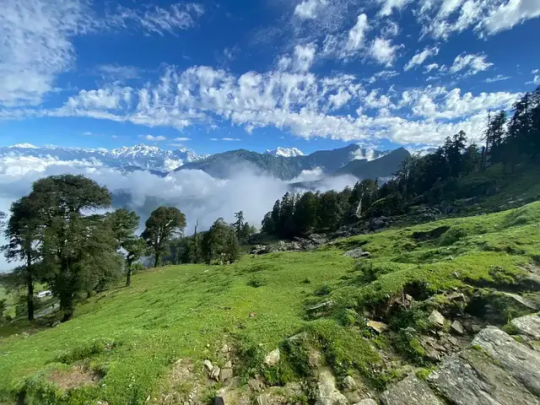
Location of the Chopta Chandrashila Trek
The Chopta Chandrashila Trek is located in the Rudraprayag district of Uttarakhand, a state in northern India. Chopta, the base camp for the trek, is a small hill station that sits at an altitude of 2,600 meters (8,500 feet) above sea level. It lies along the Gopeshwar-Tungnath road and is about 450-500 kilometers from New Delhi, the capital of India. Chopta is located in the Garhwal Himalayas, part of the Lesser Himalayas range, and is an excellent starting point for the trek to Chandrashila Peak.
The journey to Chopta is a scenic one, passing through important towns such as Haridwar, Rishikesh, Devprayag, Rudraprayag, and Gopeshwar before reaching Chopta. The terrain here is a blend of rolling hills, deep valleys, and high-altitude ridges, making it a perfect location for trekking.
Geographical Features of Chopta
Chopta is situated in the Nanda Devi Biosphere Reserve, a UNESCO World Heritage site. This biosphere reserve is home to an incredible diversity of flora and fauna, including many endemic species. The reserve’s vegetation varies according to altitude, with oak, pine, and rhododendron forests at lower elevations, giving way to alpine meadows and grasslands at higher elevations. These grasslands are also a grazing ground for migratory sheep and goats in summer.
The Chopta area is also known for its stunning panoramic views of several peaks in the Garhwal Himalayan Range, including Nanda Devi, the second-highest peak in India; Trishul, named for its trident shape; and Chaukhamba, which is one of the most famous peaks in the Uttarakhand region. These peaks dominate the skyline, creating a dramatic backdrop for trekkers as they make their way toward Chandrashila Peak.
The surrounding alpine meadows of Chopta make it an ideal spot for camping and short treks, which is why it has gained popularity among adventure enthusiasts. Additionally, Chopta serves as the base camp for trekking routes that lead to Tungnath and Chandrashila, two of the most sought-after trekking destinations in Uttarakhand.
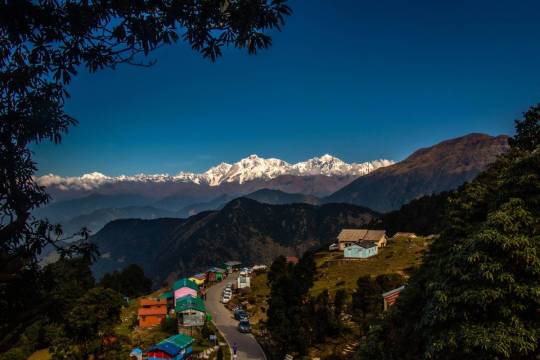
Trekking Route and Geographical Challenges
The trek from Chopta to Chandrashila Peak passes through several distinctive geographical landscapes, each adding a unique charm to the experience. Here is an overview of the terrain and the geographical features along the trekking route:
Chopta to Tungnath
The trek begins from Chopta and follows a well-defined trail leading to Tungnath, which is situated at an altitude of 3,680 meters (12,073 feet). The distance from Chopta to Tungnath is approximately 3.5 kilometers, and it is the first section of the trek. The trail is a moderately challenging uphill climb that takes trekkers through dense forests of oak, rhododendron, and pine trees. These forests are lush and green, and in the spring, they are alive with colorful rhododendron blossoms.
As trekkers ascend, they start to notice the change in the landscape, with the forest gradually thinning out and giving way to meadows. The air gets thinner, and the temperature drops as the altitude increases. Along the way, trekkers can enjoy stunning views of the surrounding valleys, with the magnificent Nanda Devi, Trishul, and Chaukhamba peaks slowly coming into view.
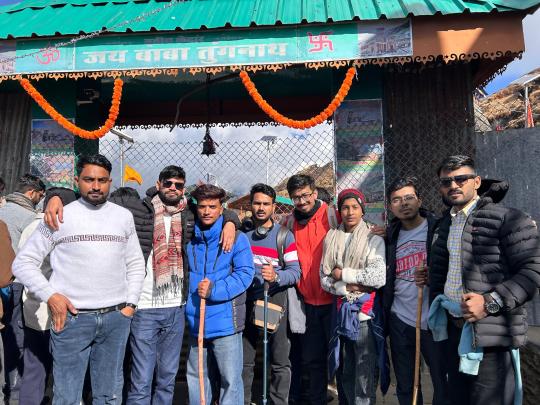
The climb from Chopta to Tungnath is not too steep, but it can be strenuous for those not used to trekking at higher altitudes. However, the beauty of the landscape makes the effort worthwhile. Once at Tungnath, trekkers can visit the Tungnath Temple, one of the highest Shiva temples in the world, which attracts pilgrims and trekkers alike.
Tungnath to Chandrashila Peak
From Tungnath, trekkers can continue to Chandrashila Peak, located at an altitude of 3,960 meters (13,000 feet). This section of the trek is more challenging, as it involves a steep climb through rocky terrain. The final ascent from Tungnath to Chandrashila is only 1.5 kilometers, but it is much steeper and can take anywhere from 1 to 2 hours to complete.
As trekkers make their way up, they pass through alpine meadows and rocky patches that require careful navigation. The air is thinner here, making the climb more strenuous. However, the view from the top of Chandrashila Peak is one of the most rewarding aspects of the trek. The summit offers panoramic views of several prominent Himalayan peaks, including Nanda Devi, Trishul, Chaukhamba, and Dunagiri, along with the Kumaon and Garhwal ranges.
The climb to Chandrashila is a physically demanding challenge, but the spectacular views of the surrounding mountains make every step worth it. Once at the top, trekkers can marvel at the breathtaking landscapes and take in the serene atmosphere of the high-altitude Himalayan environment.
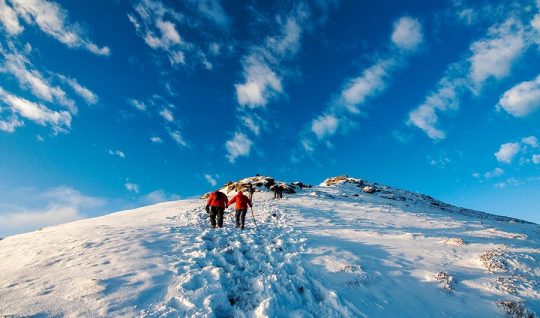
Geography of the Surrounding Region
The Chopta Chandrashila Trek lies within the Nanda Devi Biosphere Reserve and is surrounded by various other trekking destinations and geographical features of note. The trek itself is a part of the larger Nanda Devi and Valley of Flowers National Park ecosystem, which is known for its diverse flora and fauna.
Nanda Devi: The Nanda Devi mountain, which stands at 7,816 meters, is the second-highest peak in India. It is located just to the north of Chopta and is the highest peak in the Garhwal Himalayas. The Nanda Devi massif is revered by locals and is considered one of the most sacred mountains in the region.
Trishul: The Trishul peak, named after the trident of Lord Shiva, is another prominent mountain visible from the Chopta Chandrashila Trek. The Trishul massif is made up of three distinct peaks, and it is a major part of the region's geographical identity.
Chaukhamba: The Chaukhamba peaks, located near Almora, are part of the Gangotri range, and the four peaks of Chaukhamba (which rise to heights of 6,310 meters) are visible from Chandrashila. These peaks are significant both geographically and spiritually for the people of the region.
Tungnath Temple: The Tungnath Temple, located at an altitude of 3,680 meters, is a sacred site in the region and is the highest of the Panch Kedar temples dedicated to Lord Shiva. The temple attracts both trekkers and pilgrims, and the geography of the temple site offers magnificent views of the surrounding mountains.
Rivers and Streams: The region surrounding the trek is dotted with rivers and streams, including the Mandakini River, which flows through Rudraprayag, and the Alaknanda River, which meets the Mandakini at Devprayag. These rivers provide the necessary water resources for the flora and fauna of the region and contribute to the beauty of the landscapes.

Geographical Significance of Chandrashila Peak
Chandrashila, meaning “Moon Rock” in Hindi, is located near the town of Chopta, Uttarakhand, and serves as the summit of the Tungnath temple trekking route. The peak is part of the larger Garhwal Himalayan range, and its location makes it a prime spot for trekking in the Nanda Devi Biosphere Reserve, which is known for its rich biodiversity and pristine natural surroundings.
The geographical significance of Chandrashila Peak lies in its commanding position over the entire region. From the summit, trekkers and pilgrims are treated to some of the best panoramic views of the surrounding mountain ranges. These include the towering Nanda Devi, Trishul, Chaukhamba, Dunagiri, and several other prominent peaks of the Garhwal Himalayas. The surrounding valleys and meadows add to the visual appeal of the trek, with picturesque views of the snow-capped peaks that stretch as far as the eye can see.
The Chandrashila Peak is also geographically significant because of its accessibility and role as a vantage point for the Chopta Chandrashila Trek. It offers trekkers a moderately challenging ascent that is perfect for both beginners and experienced adventurers. The trek to the peak is known for its combination of alpine meadows, rocky terrain, and dense forests, providing a diverse landscape for explorers. The relatively manageable altitude compared to other Himalayan peaks allows trekkers to experience the beauty of the Garhwal Himalayas without venturing into more treacherous terrains.

Spiritual Significance of Chandrashila Peak
The spiritual significance of Chandrashila Peak is perhaps the most important reason why it is held in reverence. The peak has strong ties to Hindu mythology and is deeply linked with the story of Lord Rama. According to local legends, Chandrashila Peak is the place where Lord Rama meditated after defeating Ravana, the demon king of Lanka, in the famous battle described in the Ramayana. It is believed that Lord Rama meditated here to regain his peace and calm after the intense battle, and that the peak’s tranquility helped him connect with the divine.
The connection of Chandrashila to Lord Rama's meditation has turned the peak into a sacred site for Hindus. It is believed that the site’s spiritual energy and serene surroundings enhance one's spiritual experience, making it an ideal destination for pilgrims seeking peace and a closer connection to the divine. The Hindu mythological narrative adds a mystical aura to the place, drawing thousands of pilgrims and spiritual seekers from around the world.
Moreover, Chandrashila Peak is also linked with Lord Shiva, who is worshiped at the nearby Tungnath Temple, which is one of the Panch Kedar temples dedicated to Lord Shiva. Tungnath is the highest Shiva temple in the world and attracts not only trekkers but also pilgrims who come to pay their respects to Lord Shiva. Chandrashila, as the final point of the Tungnath Temple trek, serves as the ultimate destination for those seeking spiritual solace. The reverence for Lord Shiva and Lord Rama gives the peak its deep spiritual significance, enhancing its appeal as both a trekking destination and a pilgrimage site.
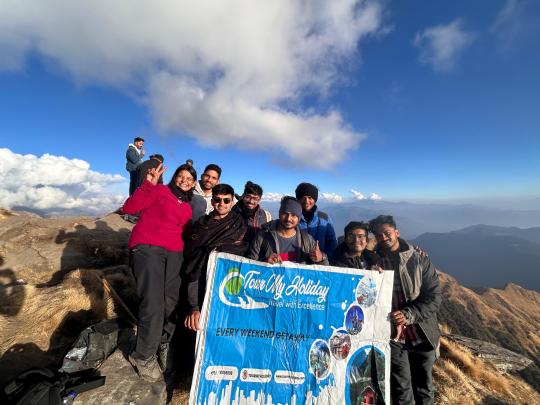
Historical Significance of Chandrashila Peak
Chandrashila Peak, an integral part of Chopta Trekking Tour Packages, is not only renowned for its trekking allure but also for its profound historical and mythological roots. Often included in Chopta Tour Package itineraries, this peak is associated with Lord Rama from the Ramayana, who is believed to have meditated here after defeating Ravana. The spiritual aura of the area extends to the Tungnath Temple Trek, which is a significant highlight for pilgrims.
For those exploring adventure and history together, Chandrashila Summit Trek is a perfect addition to Group Chopta Tours and Corporate Chopta Packages, offering both team bonding and a glimpse into India's ancient epics. Trekking enthusiasts often pair this with Deoriatal Camping Packages, where the serene lake reflects the grandeur of Chandrashila and its surrounding peaks.
Additionally, Chopta Camping Packages are ideal for those looking to connect deeply with the spiritual and natural beauty of the region. Travelers can opt for Budget Chopta Packages to explore this historically rich peak at an affordable cost. The Chopta Tungnath Trek, which encompasses Tungnath Temple and Chandrashila, encapsulates the blend of history, spirituality, and adventure that defines this iconic destination.
Chandrashila in Hindu Mythology
The historical significance of Chandrashila Peak is inextricably linked to Hindu mythology, with stories dating back thousands of years. These narratives not only provide a spiritual dimension to the peak but also highlight its importance as a cultural and religious landmark.
The Etymology of Chandrashila
The name "Chandrashila" translates to "Moon Rock" in Hindi, and its etymology is another aspect of its historical significance. According to one legend, the peak is named after Chandra, the Moon God. It is believed that Chandra meditated at this peak to appease Lord Shiva, and the place was blessed as a result.
The Moon Rock symbolism has deep roots in Hindu culture, where the moon is associated with peace, tranquility, and enlightenment. This etymological connection adds a layer of historical depth to the peak, as it ties Chandrashila to ancient Hindu cosmology and religious practices.
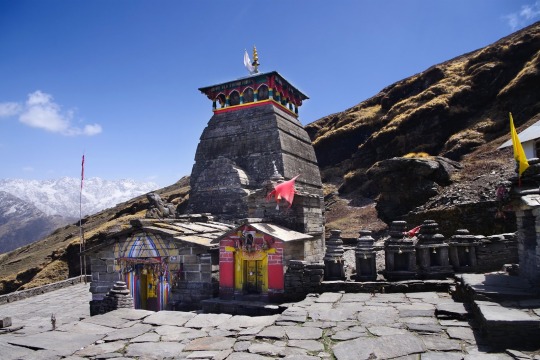
Tungnath Temple and Its Historical Importance
One cannot discuss the historical significance of Chandrashila Peak without mentioning the Tungnath Temple, located en route to the peak. Tungnath is believed to have been built over 5,000 years ago and is deeply connected to the Pandavas and their quest for salvation. The temple's ancient architecture, rich history, and spiritual aura make it a key part of Chandrashila's historical narrative.
The Panch Kedar temples, of which Tungnath is a part, are a group of five Shiva temples in the Garhwal Himalayas, each associated with a body part of Shiva that appeared after he transformed into a bull to evade the Pandavas. Tungnath represents Shiva's arms, while the other temples correspond to other body parts. The Panch Kedar pilgrimage circuit is one of the most important spiritual journeys in Hinduism, and Chandrashila Peak, as the summit of the Tungnath trek, holds an integral place in this tradition.
Historical Role in Spiritual Practices
Chandrashila Peak has been a hub for meditation and spiritual practices for centuries. The isolation and tranquility of the peak have made it an ideal location for sages, ascetics, and spiritual seekers. Ancient texts and oral traditions describe the Himalayas as a sacred region where gods and sages reside, and Chandrashila fits perfectly into this description.
Over the centuries, countless ascetics are believed to have meditated at Chandrashila, seeking enlightenment and divine wisdom. The peak's serene environment, coupled with its connection to deities like Lord Shiva and Lord Rama, has made it a place of deep spiritual resonance. Even today, pilgrims and trekkers often meditate at the peak, continuing the age-old tradition of seeking inner peace and connection with the divine.
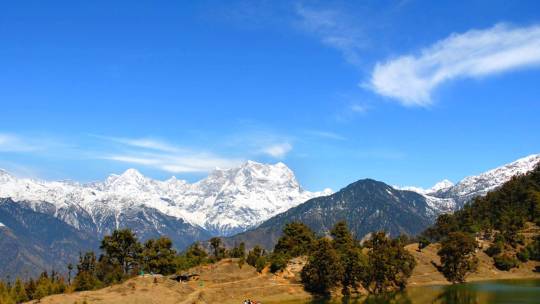
Folklore and Oral Traditions
The historical significance of Chandrashila Peak is also preserved through local folklore and oral traditions. The people of the Garhwal region have passed down stories and legends about Chandrashila for generations, keeping its cultural and spiritual heritage alive. These stories often intertwine with larger Hindu myths, creating a rich tapestry of narratives that enhance the peak's historical importance.
One such folklore involves Chandra, the Moon God, who is said to have performed penance at the peak. Another popular story relates to the Pandavas and their journey through the region. These oral traditions not only provide insight into the historical significance of Chandrashila but also reflect the deep cultural connection the local people have with the peak.
Cultural and Historical Heritage of the Garhwal Region
The Garhwal Himalayas, where Chandrashila Peak is located, have a long history of pilgrimage, spiritual practices, and cultural traditions. This region has been a focal point for Hinduism for thousands of years, with its temples, shrines, and sacred sites drawing pilgrims from across India. Chandrashila Peak is an integral part of this cultural heritage, serving as a bridge between ancient traditions and modern spiritual practices.
The cultural significance of Chandrashila is also reflected in the annual pilgrimages and festivals celebrated in the region. These events often include rituals, prayers, and ceremonies at temples like Tungnath, with Chandrashila Peak serving as the ultimate destination for spiritual seekers. The peak's role in these traditions underscores its importance as a historical and cultural landmark.
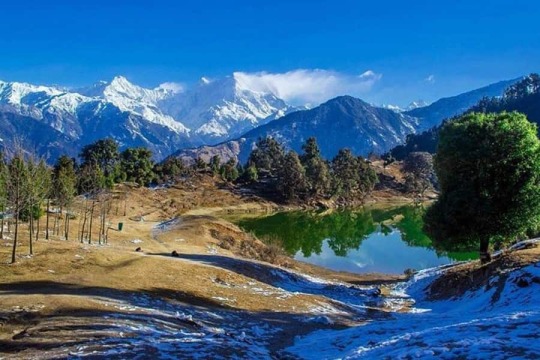
Modern Relevance of Chandrashila's Historical Significance
In modern times, Chandrashila Peak continues to be a site of historical and spiritual importance. It has become a popular trekking destination, attracting adventure enthusiasts from around the world. However, its historical and mythological significance remains a key part of its appeal. Pilgrims and trekkers alike are drawn to the peak not only for its natural beauty but also for its rich cultural and spiritual heritage.
The historical narratives associated with Chandrashila are also being preserved through efforts to promote sustainable tourism and raise awareness about its cultural importance. By combining adventure tourism with cultural education, modern initiatives aim to ensure that the historical significance of Chandrashila Peak is appreciated and preserved for future generations.
Cultural Significance of Chandrashila Peak
Nestled in the heart of the Garhwal Himalayas in Uttarakhand, Chandrashila Peak stands as a testament to the intersection of nature, spirituality, and culture. At an altitude of 3,960 meters (13,000 feet), the peak attracts not only adventure enthusiasts and trekkers but also pilgrims and spiritual seekers. Over centuries, Chandrashila has evolved into a cultural hub, rich in folklore, traditions, and rituals that define the unique identity of the Himalayan region. The cultural significance of Chandrashila Peak is deeply rooted in its mythological history, religious practices, local traditions, and its role in the lives of the Garhwali people.
This essay explores the cultural importance of Chandrashila Peak, highlighting its association with Hindu mythology, its place in regional traditions, and its role as a modern cultural icon.
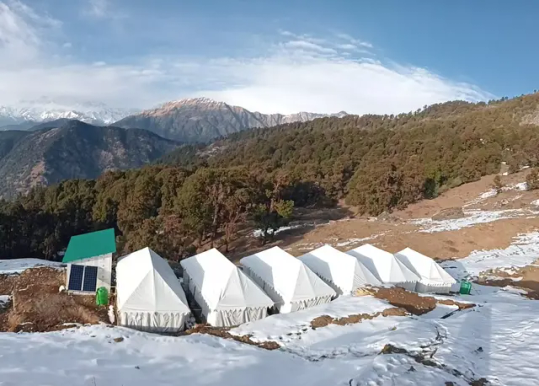
Mythological Roots and Their Cultural Impact
The foundation of Chandrashila Peak's cultural significance lies in its mythological connections, which have shaped its identity as a sacred site. Hindu mythology places Chandrashila in stories involving divine figures such as Lord Rama, Lord Shiva, and Chandra (the Moon God), which have contributed to its spiritual aura and cultural importance.
Association with Lord Rama
One of the most captivating legends associated with Chandrashila Peak is its connection to Lord Rama, the central figure of the Ramayana. According to ancient folklore, Lord Rama meditated at Chandrashila after his victorious battle against Ravana, the demon king of Lanka. The peak, with its serene and untouched ambiance, provided an ideal setting for deep reflection and spiritual rejuvenation following his epic journey.
This legendary connection elevates Chandrashila Peak to a sacred status among Hindus, making it a popular destination for pilgrims. Many visitors trek to the summit not only for the breathtaking views but also to embrace the spiritual essence of this hallowed ground. Inspired by Rama's act of meditation, trekkers often combine their adventure with moments of prayer and introspection.
Tourmyholiday offers an array of thoughtfully curated Chopta Trekking Tour Packages, which include the Chandrashila Summit Trek as a highlight for those seeking both adventure and a deeper connection to Indian mythology. For a complete experience, you can opt for Chopta Camping Packages or even Deoriatal Camping Packages, perfect for immersing yourself in the tranquil environment where Rama once meditated.
Additionally, Tourmyholiday provides budget-friendly options like Budget Chopta Packages or customized plans for Group Chopta Tours and Corporate Chopta Packages. These packages make it easy for travelers to explore the spiritual and cultural richness of the region while enjoying the adventure of the Tungnath Temple Trek and Chopta Tungnath Trek, which are intrinsically linked to the folklore of Chandrashila.
Let Tourmyholiday guide you on this journey of exploration, reflection, and discovery in the heart of the Garhwal Himalayas. Would you like a detailed itinerary or further customization for your tour?

Connection with Lord Shiva
Another pivotal figure in the cultural narrative of Chandrashila is Lord Shiva, one of the most important deities in Hinduism. The nearby Tungnath Temple, dedicated to Shiva, is part of the Panch Kedar circuit, a pilgrimage of five temples associated with Shiva's body parts. Chandrashila, located above Tungnath, is considered an extension of this spiritual journey.
The reverence for Shiva at Chandrashila reflects the broader cultural significance of the Himalayas in Hinduism, where mountains are seen as the abode of the gods. Pilgrims visiting Tungnath often climb further to Chandrashila to seek blessings and complete their spiritual experience, reinforcing its role as a site of deep cultural and religious importance.
The Legend of Chandra, the Moon God
The name “Chandrashila” translates to “Moon Rock,” and another legend ties the peak to Chandra, the Moon God. It is said that Chandra performed penance at this peak to atone for his sins, and his act of devotion imbued the place with a sacred aura. This story has added another layer of cultural depth to Chandrashila, attracting those who seek divine forgiveness and redemption.
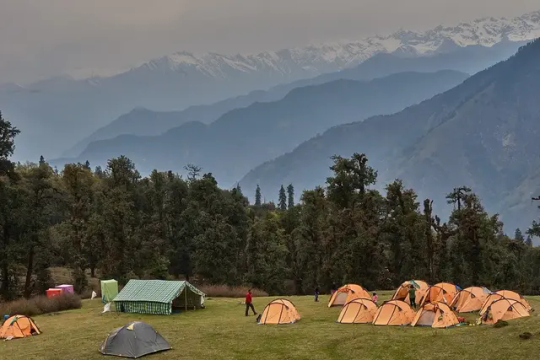
Tungnath Temple and Its Cultural Significance
The Tungnath Temple, located on the trek to Chandrashila, plays a crucial role in defining the peak's cultural identity. This ancient temple, believed to be over 5,000 years old, is the highest Shiva temple in the world. It is a key destination in the Panch Kedar pilgrimage, which holds immense significance in Hindu culture.
The temple's ancient architecture and its association with the Pandavas from the Mahabharata link Chandrashila Peak to one of the most iconic epics of Indian history. According to legend, the Pandavas built the Tungnath Temple to honor Lord Shiva and seek forgiveness for the bloodshed caused during the Kurukshetra War. This connection with the Pandavas has made the entire region, including Chandrashila, a vital part of Hindu pilgrimage traditions.
The rituals performed at Tungnath Temple and the journey to Chandrashila represent the spiritual and cultural ethos of the Garhwal Himalayas. Festivals such as Maha Shivaratri, celebrated at Tungnath, draw pilgrims from far and wide, further emphasizing the peak's role as a center of cultural activity.
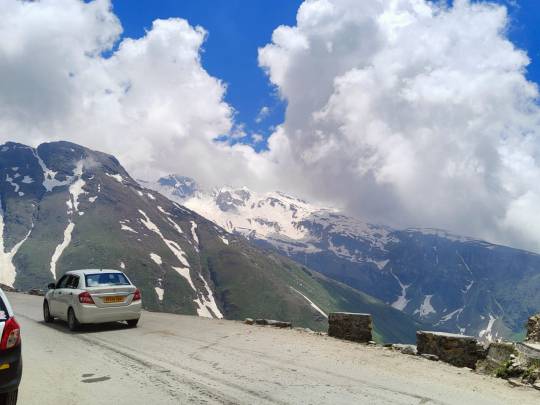
Cultural Traditions of the Garhwali People
The Garhwali people, the indigenous inhabitants of the region, play a significant role in preserving the cultural heritage of Chandrashila Peak. For these communities, the Himalayas are not just geographical features but sacred entities that are deeply intertwined with their way of life. Chandrashila Peak, with its spiritual and natural beauty, is an integral part of their cultural identity.
Local Folklore and Legends
The oral traditions of the Garhwali people are rich with stories and legends about Chandrashila. These narratives often blend mythology with local customs, creating a unique cultural tapestry. For example, stories of sages meditating at Chandrashila or of divine apparitions at the peak are passed down through generations, reinforcing its sacred status.
The Garhwali people view Chandrashila as a source of spiritual energy and inspiration. Local folklore often describes the peak as a place where the divine and mortal worlds meet, making it a site of pilgrimage not only for visitors but also for the local community.

Festivals and Rituals
Festivals in the Garhwal region often revolve around the temples and sacred sites, including Tungnath and Chandrashila. During these festivals, locals gather to perform pujas (prayers), sing traditional bhajans (devotional songs), and participate in communal feasts. These celebrations are a reflection of the region's deep-rooted cultural traditions and serve as a way to strengthen community bonds.
One of the most significant festivals in the region is Makar Sankranti, during which many pilgrims and locals visit Tungnath and Chandrashila to offer prayers. Such events highlight the cultural importance of the peak as a focal point for communal and spiritual activities.
Chandrashila as a Modern Cultural Icon
In addition to its historical and mythological significance, Chandrashila has emerged as a modern cultural icon, attracting people from diverse backgrounds. While its spiritual and religious significance remains intact, the peak has also become a symbol of adventure, exploration, and cultural exchange.
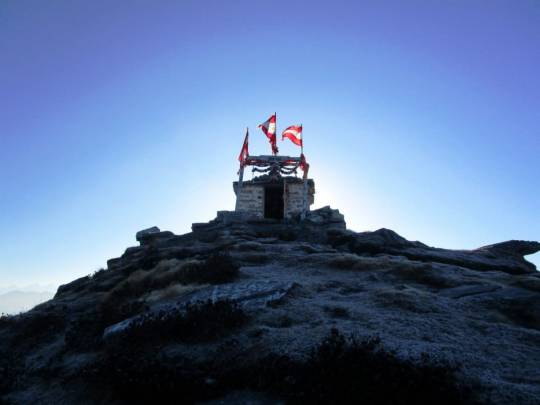
Trekking and Adventure Tourism
The Chopta-Chandrashila Trek has gained immense popularity among trekkers, offering a combination of natural beauty, spiritual experiences, and cultural immersion. For many visitors, the trek is not just a physical journey but also a cultural one, as it provides an opportunity to interact with the local Garhwali community and learn about their traditions.
The trek passes through quaint villages, alpine meadows, and dense forests, offering trekkers a glimpse into the Himalayan way of life. Many trekkers participate in local rituals at Tungnath Temple and meditate at Chandrashila, blending adventure with cultural exploration.
Cultural Exchange
The influx of tourists and trekkers to Chandrashila has created opportunities for cultural exchange between the Garhwali people and visitors from across India and the world. Tourists often get to experience local hospitality, taste traditional Garhwali cuisine, and witness cultural performances such as folk dances and music. This exchange enriches the cultural significance of Chandrashila by fostering mutual respect and understanding.

Chandrashila and Environmental Stewardship
The cultural significance of Chandrashila is also tied to its role as a symbol of environmental preservation. The Garhwali people have a deep reverence for nature, viewing it as a manifestation of the divine. This philosophy is evident in their efforts to protect the region's biodiversity and maintain the sanctity of sacred sites like Chandrashila.
The peak's cultural narrative often includes stories of sages and deities emphasizing the importance of living in harmony with nature. Modern efforts to promote eco-tourism in the region are a continuation of these traditional values, ensuring that Chandrashila's natural and cultural heritage is preserved for future generations.
Tourism and Adventure Significance
Chandrashila Peak, nestled in the Garhwal Himalayas of Uttarakhand, is one of India’s most sought-after trekking and adventure destinations. Known for its breathtaking natural beauty, spiritual importance, and challenging terrain, it attracts adventure enthusiasts, nature lovers, photographers, and pilgrims alike. Its accessibility and diverse offerings make it a hub of tourism and a significant contributor to the adventure tourism circuit in the region. Let’s explore the tourism and adventure significance of Chandrashila Peak in detail:
1. A Haven for Adventure Enthusiasts
The Chandrashila trek is often hailed as one of the most rewarding yet beginner-friendly treks in the Himalayas. It combines scenic trails, diverse terrains, and an elevation of approximately 4,000 meters, making it a perfect introduction to high-altitude trekking.
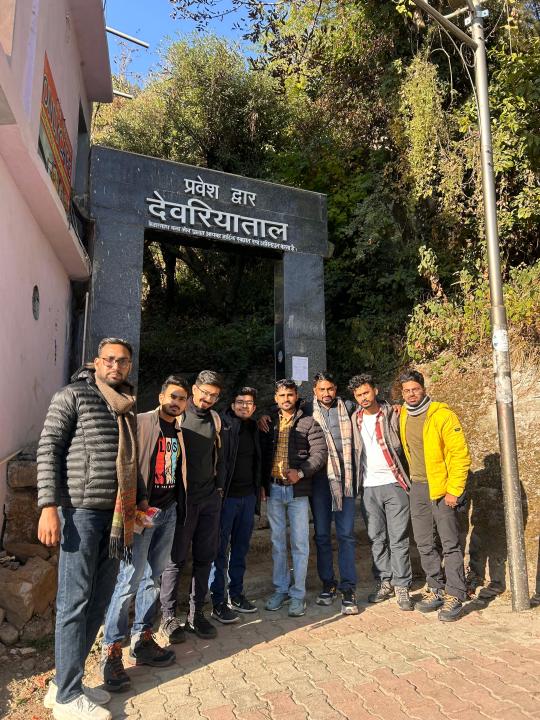
Key Adventure Highlights:
Trekking: The trek offers a mix of easy to moderately steep ascents, catering to both beginners and experienced trekkers. The route passes through dense forests, sprawling meadows, and snowy trails, making it a versatile adventure.
Snow Trekking in Winter: During winter (December to March), the region transforms into a snow-laden paradise. Trekking on icy trails amidst snow-covered landscapes is an unforgettable experience for thrill-seekers.
Camping: Camping under star-lit skies amidst serene surroundings is another major draw for adventurers.
Photography: The panoramic views of some of the tallest Himalayan peaks, including Nanda Devi, Kedarnath, Trishul, and Chaukhamba, make it a haven for photographers.
The accessibility of the trek and the variety of experiences it offers make Chandrashila a prime destination for adventure tourism.
2. Spiritual and Pilgrimage Tourism
Chandrashila Peak has immense spiritual significance, particularly for devotees of Lord Shiva. The trek is closely associated with Tungnath Temple, the highest Shiva temple in the world, located on the route to the peak.
Spiritual Highlights:
Tungnath Temple: Pilgrims from across the country undertake the trek to visit this sacred temple, believed to be over 1,000 years old. Its location amidst the Himalayas enhances its spiritual aura.
Mythological Importance: According to legends, Chandrashila is the spot where Lord Rama meditated after defeating Ravana. It is also believed to be the place where Lord Shiva meditated, making it a revered site for Hindus.
This blend of spirituality and adventure draws a unique mix of tourists, including pilgrims seeking a spiritual retreat and trekkers drawn to its cultural heritage.
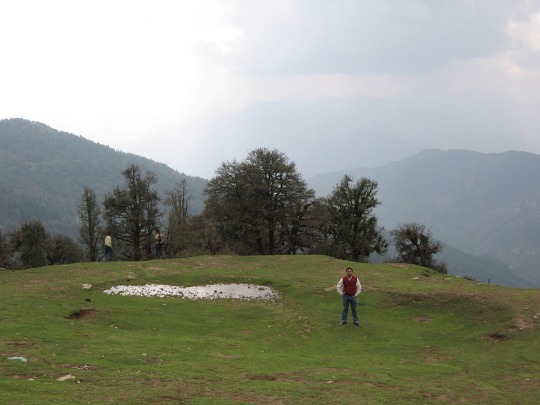
3. Ecotourism and Nature Exploration
The Chandrashila trek passes through the Kedarnath Wildlife Sanctuary, adding an ecotourism dimension to the adventure. The sanctuary is home to diverse flora and fauna, including Himalayan musk deer, leopards, and a variety of bird species.
Nature Highlights:
Rich Biodiversity: Trekkers often spot rare birds, such as the Himalayan monal, the state bird of Uttarakhand, along the trails.
Flora and Fauna: The trek offers a close connection with nature, passing through rhododendron forests, alpine meadows, and pristine streams.
Stargazing: The clear skies at high altitudes make Chandrashila an excellent destination for stargazing and astrophotography.
This ecological richness enhances its appeal for tourists who seek a closer connection with nature and the environment.
4. Accessibility and Proximity to Other Destinations
Chandrashila Peak’s accessibility makes it a popular choice for tourists:
It is located near Chopta, known as the "Mini Switzerland of India," which serves as the base for the trek.
The trek can be completed in 2–3 days, making it ideal for weekend getaways or short trips.
Its proximity to other attractions like Deoria Tal, Tungnath Temple, and the Kedarnath shrine adds to its tourism appeal.

5. Boost to Local Tourism and Economy
The popularity of Chandrashila Peak has significantly contributed to the local economy:
Homestays and Guesthouses: Villages around Chopta have developed homestays and small guesthouses to cater to tourists.
Adventure Tourism: Local guides, trek organizers, and porters benefit directly from the influx of trekkers and adventure enthusiasts.
Cultural Exchange: The trek allows visitors to interact with local communities, offering an opportunity to experience the traditions and hospitality of Uttarakhand.
Trekking Experience: A Journey of Diversity
The Chandrashila Trek begins in Chopta, a picturesque hill station surrounded by breathtaking landscapes in the Garhwal Himalayas. Known for its pristine natural beauty, Chopta offers lush meadows, dense forests, and spectacular views of snow-capped peaks, making it a dream destination for nature lovers and adventure seekers alike. This serene starting point sets the stage for an unforgettable trekking experience, making it a favorite choice for Adventure Tours in Chopta.
As one of the highlights of Himalayan Treks, Chopta boasts rich biodiversity, with its unique flora and fauna enhancing the trekking experience. Trekkers often feel a deep connection with nature, thanks to the soothing melodies of birdsong and the crisp mountain air. Planning your adventure with a detailed Chopta Trek Itinerary ensures a seamless and memorable journey.

1. The Starting Point: Chopta - Mini Switzerland of India
The trek to Chandrashila typically begins at Chopta, a quaint hill station often referred to as the "Mini Switzerland of India." Chopta itself is a marvel of nature, surrounded by lush meadows, dense forests, and snow-capped peaks. The serene atmosphere of this starting point sets the tone for the adventure ahead, making it a favorite spot for trekkers and nature lovers.
Chopta is a hub of biodiversity, with a variety of flora and fauna that add to the trek’s charm. Trekkers are often greeted by the chirping of birds, the rustling of leaves, and the crisp mountain air, creating an immediate connection with nature.
2. Trekking Through Diverse Landscapes
One of the most captivating aspects of the Chandrashila trek is the diversity of landscapes encountered along the route. The trail winds through a mix of terrains, offering trekkers an ever-changing backdrop of natural beauty.
Forests: The trek starts with a journey through dense forests of oak, deodar, and rhododendron. In spring, these forests burst into vibrant colors as the rhododendron trees bloom with bright red and pink flowers, creating a magical atmosphere.
Meadows: The forest trail opens up to vast alpine meadows, or bugyals, which offer panoramic views of the surrounding peaks. These meadows are perfect for resting and soaking in the beauty of the Himalayas.
Snow Trails: During winter, the trail is blanketed in snow, adding an element of challenge and excitement. Trekking through snow-laden paths with views of the glittering peaks is a surreal experience.
Rocky Ascents: The final stretch to Chandrashila involves a steep, rocky ascent, testing the physical endurance and mental determination of trekkers.
3. Spiritual Significance Along the Way
The trek passes through Tungnath Temple, the highest Shiva temple in the world, situated at an altitude of 3,680 meters. The temple is a site of immense spiritual importance, attracting both pilgrims and trekkers. Many consider the trek a spiritual journey, combining adventure with a sense of divine connection. The peaceful environment of Tungnath adds a layer of serenity to the trek.
4 Test of Physical and Mental Strength
The Chandrashila trek is moderately challenging, making it accessible to beginners while still providing a sense of adventure for experienced trekkers. The varying terrains, high altitudes, and weather conditions demand physical fitness and mental resilience. For many, the trek becomes a journey of self-discovery, pushing their limits and fostering a sense of achievement.

5. Cultural and Ecological Diversity
The trek also offers opportunities to interact with the local communities of Uttarakhand, who are known for their warmth and hospitality. Trekkers get a glimpse into the region’s rich cultural heritage, traditional practices, and simple way of life. Additionally, the trail passes through the Kedarnath Wildlife Sanctuary, home to rare species such as the Himalayan monal, musk deer, and various medicinal plants. This biodiversity adds an element of ecological awareness to the journey.
Things to Carry for the Trek
Given the moderate difficulty of the trek and the high-altitude environment, it is important to pack appropriately for the journey. Here’s a list of essential items:
Clothing: Layered clothing for cold weather, waterproof jackets, warm woolen caps, gloves, and trekking shoes.
Backpack: A comfortable backpack to carry essentials like water, snacks, and personal items.
Sleeping Bag and Tent: If you're camping, carry a good quality sleeping bag and a lightweight tent.
First Aid Kit: Basic medications, bandages, antiseptics, and any personal medications.
Snacks and Energy Bars: To keep your energy levels high during the trek.
Sunscreen and Sunglasses: For sun protection at high altitudes.
Camera: To capture the beautiful landscapes and memories of the trek.

How to Reach Chopta from Delhi
The journey from Delhi to Chopta is quite an adventure in itself. Here's how you can travel from Delhi to Chopta:
By Road (Approx. 12-13 Hours):
Chopta is approximately 450-500 km from Delhi, and it takes around 12-13 hours to reach by road. You can either travel in a private car, cab, or opt for a bus.
The route takes you through scenic landscapes, passing through cities like Haridwar, Rishikesh, Devprayag, and Rudraprayag, which are all important landmarks in Uttarakhand.
The final stretch from Rudraprayag to Chopta is a narrow, winding road, so be prepared for some steep climbs.
By Train:
The nearest major railway station is Rishikesh, which is around 200 km from Chopta. From Rishikesh, you can hire a taxi or take a local bus to reach Chopta.
You can board a train from New Delhi Railway Station to Haridwar or Rishikesh, and then continue your journey to Chopta.
By Air:
The nearest airport to Chopta is Jolly Grant Airport in Dehradun (about 180 km away). From Dehradun, you can hire a taxi or use public transport to reach Chopta.

Trekking Route and Difficulty Level
The trek to Chandrashila Peak begins from Chopta, which is surrounded by lush meadows and dense forests. The Chopta to Tungnath stretch is around 3.5 km, and it takes approximately 2 to 3 hours to reach the Tungnath Temple. From there, you begin the final ascent to Chandrashila Peak, which is about 1.5 km further. This section is steeper and can take an additional 1 to 1.5 hours to complete.
Day 1: Delhi to Chopta
Start your journey early from Delhi by road or train.
Reach Chopta by evening.
Stay in local guesthouses or campsites.
Day 2: Chopta to Tungnath
Begin your trek from Chopta to Tungnath Temple early in the morning.
It’s a moderate 3.5 km climb that takes you through a dense forest of oak and rhododendron trees.
After reaching Tungnath, visit the ancient temple.
Rest for the night in a guesthouse or camp near Tungnath.
Day 3: Tungnath to Chandrashila Peak
Start early in the morning for the summit of Chandrashila.
The final ascent is steep, but the stunning views of the surrounding mountains make it worth every step.
After reaching the top, enjoy panoramic views of the Himalayan peaks and the valley below.
Return to Tungnath and Chopta by evening.
Day 4: Chopta to Delhi
Descend from Chopta and head back to Delhi, concluding your trekking adventure.

Best Time to Visit
Chandrashila Peak, perched in the majestic Garhwal Himalayas, is a sought-after destination for trekkers, nature lovers, and spiritual seekers alike. Its stunning landscapes, cultural significance, and breathtaking views of some of India’s tallest peaks make it a year-round destination. However, the experience of visiting Chandrashila varies dramatically depending on the season. The best time to visit the peak depends on the kind of experience you’re seeking, whether it’s trekking through snow, basking in the vibrant greenery of summer, or witnessing the riot of colors during autumn.
Here’s a detailed breakdown of the best seasons to visit Chandrashila Peak:
1. Summer Season (April to June)
The summer months are considered the most popular time to visit Chandrashila Peak. During this period, the weather is pleasant, with temperatures ranging between 10°C to 25°C, making it ideal for trekking and outdoor activities. The snow from winter begins to melt, uncovering lush green meadows, blooming flowers, and vibrant forests along the trekking route.
Highlights of Visiting in Summer:
Comfortable Weather: Mild temperatures make trekking easier and more enjoyable.
Open Trails: The snow clears, allowing safe and accessible trekking paths.
Tungnath Temple: The famous Tungnath Temple opens its doors to pilgrims in late April or early May, making it an excellent time for spiritual seekers.
This season is perfect for beginners and those looking for a scenic and peaceful trek with clear skies and uninterrupted views of the surrounding peaks like Nanda Devi, Trishul, and Chaukhamba.
2. Monsoon Season (July to September)
The monsoon season brings heavy rainfall to the Garhwal region, making trekking to Chandrashila a challenging endeavor. The trails can become slippery and prone to landslides, posing risks for visitors. However, for those who enjoy solitude and misty landscapes, this season offers a unique charm.
Highlights of Visiting in Monsoon:
Lush Greenery: The meadows and forests come alive with vibrant greenery, offering a surreal and serene environment.
Peaceful Experience: With fewer tourists, the trek is quieter, providing a sense of solitude.
However, due to the risks associated with heavy rains, monsoon is generally not recommended unless you are an experienced trekker or a nature lover willing to take extra precautions.
3. Autumn Season (October to November)
Autumn is considered the best season to visit Chandrashila Peak, offering clear skies, crisp weather, and stunning landscapes. The temperatures range between 5°C to 15°C, making it ideal for trekking. The views during this season are unparalleled, with the majestic Himalayan peaks visible in their full glory.
Highlights of Visiting in Autumn:
Crystal Clear Views: The post-monsoon clarity ensures stunning panoramas of snow-clad peaks.
Pleasant Weather: Neither too cold nor too warm, the weather is perfect for outdoor adventures.
Cultural Experience: This is a great time to experience local festivals and traditions in nearby villages.
Autumn is ideal for photographers, experienced trekkers, and anyone looking for a mix of natural beauty and cultural immersion.
4. Winter Season (December to March)
For adventure enthusiasts and those seeking a snow-filled experience, winter is an excellent time to visit Chandrashila. During this period, the region transforms into a snowy wonderland, with temperatures ranging from -8°C to 10°C. The trek to Chandrashila becomes more challenging, but the rewards are equally mesmerizing.
Highlights of Visiting in Winter:
Snow Trekking: The snow-covered trails offer a thrilling trekking experience, perfect for adventure lovers.
Pristine Beauty: The landscape is blanketed in snow, creating a serene and magical atmosphere.
Unique Views: The peaks look more majestic under the winter sun, and the tranquility of the surroundings is unmatched.
However, the Tungnath Temple remains closed during winter, and trekkers must prepare adequately for the cold and challenging conditions.
What to Pack
Packing appropriately for the Chandrashila trek is crucial for ensuring a safe, comfortable, and enjoyable experience. Whether you’re embarking on this trek in the summer, autumn, or the challenging winter season, the right gear and essentials can make all the difference. The trek involves varying terrains, unpredictable weather conditions, and high altitudes, so a well-prepared packing list is vital. Here's a comprehensive guide on what to pack for the Chandrashila trek:
1. Clothing Essentials
Layering is key when trekking in the Himalayas, as temperatures can vary drastically depending on the time of day and altitude. Here’s what you’ll need:
Base Layers
Moisture-wicking thermal inners (top and bottom) to keep your body warm and dry during cold conditions.
A set of quick-dry t-shirts for trekking during the day.
Mid Layers
Insulating fleece or light sweaters to provide warmth in moderate cold.
A down jacket or a padded jacket is essential for chilly evenings and mornings.
Outer Layers
A waterproof and windproof jacket to protect against sudden rain or snow.
Trekking pants that are lightweight, quick-drying, and comfortable for long walks.
Additional Items
A pair of thermal or woolen gloves to keep your hands warm.
Woolen socks (2–3 pairs) and synthetic trekking socks (2–3 pairs) to keep your feet warm and blister-free.
A woolen cap or beanie to protect your head and ears from the cold.
A balaclava or scarf for additional warmth and protection from wind.
Lightweight rain poncho or waterproof cover for sudden weather changes.
2. Footwear
Trekking shoes: Sturdy, well-fitted, and waterproof trekking boots with good grip are a must. Break them in before the trek to avoid blisters.
Sandals or slippers: Useful for relaxing at the campsite or guesthouse.
Gaiters (optional): Essential for winter treks to prevent snow from entering your boots.
3. Trekking Gear
A backpack (30–40 liters) with adjustable straps and rain cover to carry all your essentials.
A daypack (10–15 liters) for shorter hikes or to carry water and snacks during the trek.
Trekking poles to reduce strain on your knees and improve balance, especially during steep ascents or descents.
Headlamp or flashlight with extra batteries for early morning or late evening treks.
Sleeping bag (if not provided by the trek organizer) suitable for sub-zero temperatures.
4. Personal Essentials
Water bottles or a hydration bladder (2 liters minimum). Insulated bottles are useful for winter treks.
Energy bars, dry fruits, or snacks: High-energy food to keep you fueled during the trek.
Sunscreen lotion (SPF 30 or higher) to protect against sunburn at high altitudes.
Lip balm to prevent chapped lips caused by cold and dry air.
Sunglasses with UV protection to shield your eyes from the harsh glare of the sun and snow.
5. First Aid Kit and Toiletries
A basic first aid kit with band-aids, antiseptic cream, pain relievers, and any personal medications.
ORS (Oral Rehydration Salts) or electrolyte powders to stay hydrated and combat fatigue.
Toiletries such as biodegradable soap, toothbrush, toothpaste, wet wipes, and hand sanitizer.
Toilet paper or tissues, as these may not be readily available along the route.
6. Miscellaneous Items
ID Proof: Carry valid government-issued identification for registration or permits.
Trekking permits: Ensure you have all necessary permissions arranged by yourself or your trek organizer.
Camera or smartphone: To capture the stunning views of Chandrashila and the surrounding peaks.
Power bank: For charging devices, as electricity may be limited or unavailable in some areas.
Ziplock bags: Useful for keeping electronics or documents safe from moisture.
Notebook and pen: Optional, for journaling your experiences.
7. Winter-Specific Additions
If you’re trekking during winter (December to March), pack the following additional items:
Microspikes or crampons for better grip on icy trails.
Extra thermal layers and heavier jackets for extreme cold.
Hand and foot warmers for added comfort.
8. Packing Tips
Pack light: Carry only the essentials, as a heavy backpack can slow you down and tire you out quickly.
Use compression sacks: These help save space by compacting bulky items like jackets and sleeping bags.
Distribute weight evenly: Pack heavier items close to your back and at the bottom of your bag for better balance.
Double-check gear: Ensure your trekking shoes, backpack, and gear are in good condition before starting the trek.
FAQs on Chopta Chandrashila Trek
1. What is the best time to undertake the Chopta Chandrashila Trek? The trek can be undertaken year-round, but the best times are:
Spring (March to May): When rhododendrons bloom, offering vibrant trails.
Winter (December to February): For those seeking snow-covered landscapes.
Autumn (September to November): Clear skies and stunning views of the Himalayan peaks.
2. How difficult is the Chopta Chandrashila Trek? The trek is considered moderate, making it suitable for beginners as well as experienced trekkers. However, the final ascent to Chandrashila Peak involves a steep climb, which can be physically demanding.
3. What is the altitude of Chandrashila Peak? Chandrashila Peak is situated at an altitude of approximately 3,960 meters (13,000 feet) above sea level.
4. How do I reach Chopta, the starting point of the trek?
By Road: Chopta is well-connected by road from cities like Rishikesh, Haridwar, and Dehradun.
By Rail: The nearest railway station is in Haridwar (approximately 200 km).
By Air: The nearest airport is Jolly Grant Airport in Dehradun, about 220 km away.
5. What are the key attractions during the trek?
Tungnath Temple: The highest Shiva temple in the world, located at 3,680 meters.
Chandrashila Summit: Offers panoramic views of peaks like Nanda Devi, Trishul, Chaukhamba, and Kedarnath.
Deoriatal Lake: A tranquil high-altitude lake surrounded by lush forests.
6. Do I need a guide for the trek? While the trail is well-marked, hiring a guide is recommended, especially for first-timers or during winter. Guides can enhance your experience with local insights and ensure safety.
7. What should I pack for the trek? Essential items include:
Warm clothing (layers, gloves, thermals)
Sturdy trekking shoes
Trekking poles
Raincoat or poncho
First aid kit and personal medications
Energy snacks and water bottles
8. Are there any camping options during the trek? Yes, you can camp at Chopta, Tungnath, or near Deoriatal. Many Chopta Camping Packages include camping gear, meals, and facilities.
9. Is the trek suitable for solo travelers? Yes, but solo travelers are advised to join Chopta Group Tours for safety and companionship, especially during winter or if unfamiliar with the region.
10. What is the weather like during the trek?
Spring/Summer: Pleasant with temperatures ranging from 5°C to 20°C.
Winter: Cold, with temperatures dropping to -5°C or lower, and snow along the trail.
Monsoon (July-August): Rainy and slippery, less ideal for trekking.
11. How long is the trek, and how many days are required? The trek covers approximately 10-15 km (round trip) and typically requires 2–4 days, depending on your itinerary and pace.
12. Are permits required for the trek? Currently, there is no permit requirement for the Chopta Chandrashila Trek, but entry fees may apply at Deoriatal or other specific areas.
13. What fitness level is required for the trek? Moderate fitness is sufficient. Prepare with basic cardio and endurance exercises like jogging, cycling, or stair climbing a few weeks before the trek.
14. Are there food and water facilities on the trail? Basic food is available at Chopta and a few dhabas along the trail. However, it is advisable to carry water bottles and refill them at natural water sources.
15. Can the trek be combined with other activities? Yes, the trek is often paired with:
Adventure Tours in Chopta (e.g., rock climbing, rappelling)
Birdwatching and photography
Visiting nearby destinations like Ukhimath and Kedarnath
16. Is the trek child-friendly? Children above 8 years with good fitness can undertake the trek, especially in summer or autumn. Winter trekking may be challenging for younger children due to cold and snow.
17. What wildlife can I expect to see during the trek? The trail passes through the Kedarnath Wildlife Sanctuary, home to species like musk deer, Himalayan monal, and a variety of birds and butterflies.
18. Are there medical facilities available on the trail? There are no medical facilities along the trail. Trekkers are advised to carry a first aid kit and personal medications. The nearest healthcare centers are at Ukhimath or Rudraprayag.
19. Is Chandrashila Trek part of the Char Dham Yatra? No, but it lies close to Kedarnath, one of the Char Dham destinations. Pilgrims often combine the trek with a visit to Kedarnath or Badrinath.
20. What are the best trekking packages for the Chandrashila Trek? Various trekking operators offer Best Trekking Packages, including options for:
Tungnath Temple Trek
Chopta Tungnath Trek
Winter or summer trek packages
Group or corporate tours tailored to your preferences.
For customized packages and hassle-free bookings, check out TourMyHoliday to make your trek an unforgettable experience!
#chopta tungnath trek#chopta auli#chopta itinerary#chopta tour package from haridwar#chopta tour package from delhi#chopta cheapest#chopta tour itinerary#tourmyholiday#delhi to chopta tour at best price#auli complete tour package#chopta tour package#chopta group tours#chopta chandrashila trek#winter trekking in uttarakhand#tungnath trekking guide#tungnath temple trek#chandrashila summit trek
0 notes
Text

Chopta Getaway: Perfect Chopta Tour Package for the Best Time to Visit!
Embark on an unforgettable journey to Chopta with TourMyHoliday’s exclusive 2-night, 3-day Chopta tour package for just ₹5999! Nestled in the heart of Uttarakhand, Chopta is renowned for its breathtaking landscapes and serene ambiance. This package offers you the perfect opportunity to explore the stunning meadows, majestic mountains, and picturesque views that this destination has to offer. With the best time to visit being during the spring and autumn months, you'll experience ideal weather and vibrant scenery. Enjoy guided treks, cozy accommodations, and delicious meals, all while immersing yourself in the natural beauty of Chopta. Don’t miss out on this incredible adventure—book your getaway today!
#ChoptaTourPackage#TungnathTrek#ChoptaTripPackage#TourMyHoliday#HimalayanAdventures#ChoptaTravel#TourPackages#IncredibleIndia#Chopta tungnath trek#Chopta auli#Chopta itinerary#Chopta tour package from delhi#Chopta tour package from Haridwar#Chopta complete tour package#Chopta best hotels#Delhi to chopta tour at best price#Delhi#chopta#auli complete tour package#Cheapest tour tour package of chopta#Chopta chandrashila trek#Chopta cheapest#Chopta tour itinerary#Best resort in chopta
0 notes
Text

Choose TourMyHoliday for Your Chopta Tour Package
When it comes to exploring the mesmerizing landscapes of Chopta, choosing the right travel company can make all the difference. Here’s why TourMyHoliday stands out as the best Chopta tour company for your adventure
Choose TourMyHoliday for Your Chopta Tour Package

When it comes to exploring the mesmerizing landscapes of Chopta, choosing the right travel company can make all the difference. Here’s why TourMyHoliday stands out as the best Chopta tour company for your adventure
#Chopta tungnath trek#Chopta auli#Chopta itinerary#Chopta tour package from delhi#Chopta tour package from Haridwar#Chopta complete tour package#Chopta best hotels#Delhi to chopta tour at best price#Delhi#chopta#auli complete tour package#Cheapest tour tour package of chopta#Chopta chanadrashila trek#Chopta cheapest#Chopta tour itinerary#Best resort in chopta#ChoptaTourPackage#TungnathTrek#ChoptaTripPackage#TourMyHoliday#HimalayanAdventures#ChoptaTravel#TourPackages#IncredibleIndia
0 notes
Text
#uttarakhand#travel#chopta#auli#badrinath#kedarnath#gangotri#aulitour#yamunotri#haridwar#chardhamyatra2024#chardhamtaxi#bestchardhamtouroperator
0 notes
Text
Luxury Harsil tour Package
Experience the epitome of luxury amidst the enchanting landscapes of Harsil with our exclusive tour package. Immerse yourself in the serene beauty of this hidden gem of Uttarakhand with the help our luxury Harsil tour package while indulging in opulent accommodations and personalized service. Explore the pristine beauty of Harsil's valleys, rivers, and forests, and immerse yourself in the tranquility of this offbeat destination. Join us for an unforgettable journey of relaxation, rejuvenation, and indulgence in the lap of luxury in Harsil.
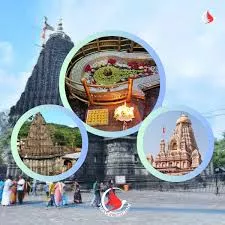
0 notes
Text

The Himalayas run from the north most of Jammu and Kashmir to down of the northeastern state of Tripura. It is the largest mountain range in the world. It homes many flora and fauna, jagged peak valleys, glaciers, unfathomable river gorges. They play an important role in the climate of India.
Chandrashila is the summit above Tungnath temple in India. It literally means "Moon Rock". It is located at a height of about 3,690 metres above sea level. This peak provides views of the Himalayas, including Nandadevi, Trisul, Kedar Peak, Bandarpunch and Chaukhamba peaks.
To see the homes of flora and fauna explore Himalayas with us this month From 21st may 28 the may ( Himalayan hiking yoga retreat)
To book your spot what's app at +91 8077047879
#chandrashila#chopta#uttarakhand#tungnath#uttarakhandheaven#kedarnath#mountains#himalayas#uttarakhandtourism#trekking#travel#uttrakhand#garhwal#incredibleindia#dehradun#india#rishikesh#auli#ukhimath#rudraprayag#travelphotography#badrinath#pithoragarh#chamba#munsyari#nature#paurigarhwal#himachal#satpuli#pindleindia
#chandrsila#chopta#uttarakhand#tungnath#uttarakhandheaven#kedarnath#mountains#himalayas#uttarakhandtourism#trekking#travel#garhwali#incredibleindia#dehradun#india#rishikesh#auli#ukhimath
0 notes
Text

Discover mesmerizing Auli Chopta tour package by Badri Kedar Holidays. Experience Uttarakhand's beauty. Book now for unforgettable memories!
0 notes